Mi, Mío, Mía (My, Mine)
WAYS WE CAN USE THE WORD(S)
COMMENT: e.g., Mi gato es grande (My cat is big); Es mío/ Es mía (It is mine); La galleta es mía (The cookie is mine).
ASK QUESTIONS: e.g., ¿Es mío?/¿Es mía? (Is it mine?)
NEGATE: e.g., No es mío/No es mía (It’s not mine).
INTRODUCE: e.g., Mi nombre es Juan (My name is Juan).
DISCUSS AN INTEREST: e.g., Mi animal favorito es el león (My favorite animal is the lion).
DIRECT ACTION: e.g., Dame mi mochila, por favor (Give me my backpack, please).
TAKE TURN: e.g., Es mi turno (It’s my turn).
EXPRESS OPINIONS: e.g., La tuya es mejor que la mía (Yours is better than mine).
GRAMMATICAL USAGE OF THE WORD(S)
Mío (masculine) and mía (femenine) are possessive pronouns. Their gender corresponds to the gender of the thing possessed, not the gender of the possessor. Mío and mía translate to “mine” in English. Mi translates to “my,” and is placed before a noun. The plural form of mío is míos, and the plural form of mía is mías. The plural form of mi is mis.
This core word activity sheet was created by Angela Rowell. It was adapted from the School Year of Core Words worksheet for “my/mine” by Shanaz Faisal.
Snack/mealtimes: During mealtime or snack time, the adult can elicit the core word(s) from the student by pointing to the student’s food items and asking who certain food items belong to, e.g., “¿De quién es esta manzana?” (Whose apple is this?). The student can be prompted to give responses such as, “Es mi manzana” (It’s my apple) or “Es mía” (It’s mine). Students can use “Es mío” when describing masculine nouns.
Circle Time: When reviewing the body parts, the adult can verbally and gesturally model phrases such as, “mi nariz, mis ojos, mi cabeza” (my nose, my eyes, my head). Students can practice producing these utterances and signaling to these body parts on themselves. The song “Las partes del cuerpo” by Rockalingua can be incoporated into this activity.
Class norms: Throughout the daily routine, adults can emphasize classroom norms with incorporate the core word(s), e.g., reminding students that they can use the utterance “Mi turno” (My turn) during activities which require students to take turns or share. The adult can also remind students of other class norms, e.g., “Respeto a mis compañeros” (I respect my classmates). Visuals which can be used to teach classroom norms are available for free on the Teachers Pay Teachers website.
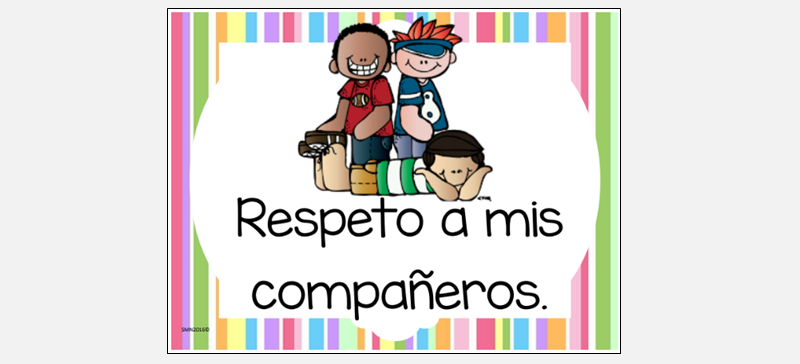
Toys and Games: When playing games, the adult can encourage students to use the utterance “Mi turno” (My turn) to indicate that it is their turn to play. Adults can also point to particular toys and ask questions such as, “¿De quién es este juguete?” (Whose toy is this?), to which students can respond, “Es mío” (It’s mine). Students can use “Es mía” when describing feminine nouns.
Playing with dolls or other toys: When students are playing with toys such as dolls or stuffed animals, the adult can prompt students to narrate what their toy is doing, e.g., “Mi muñeca está durmiendo” (My doll is sleeping). In response, students can produce utterances such as, “La mía está en la cocina. (Mine is in the kitchen).
Cars: When playing with toy cars, the adult can prompt students to describe what their car is doing, e.g., “Mi coche va rápido” (My car goes fast). Peers can respond with utterances such as, “El mío va lento” (Mine goes slow).
Building Sandcastles: During recess, the adult can build sandcastles with students, prompting students to describe their sandcastles, e.g., “Mi castillo de arena es grande” (My sandcastle is big) or “El mío es pequeño.”
Here are some suggested books on YouTube that can assist in teaching the core word(s). Model the core words mi, mío, and mía on the student’s communication system as they appear in the stories.
Books With a Family Theme:
- Mi mamá: By Anthony Browne | Children's Book Read Aloud by Adri Casablancas
- This story describes all of the positive and magical qualities that the narrator’s mother possesses. This book can be incorporated into lessons about family members and love. A version of this book about fathers, and also written by Anthony Browne, can be found here.
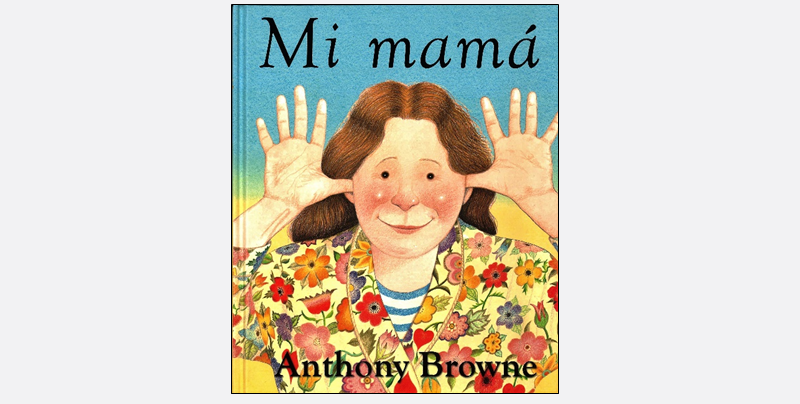
- Mi abuela es una estrella: By Carl Norac and Ingrid Godon | Children's Book Read Aloud by Cuentos Educativa
- This book narrates all of the wonderful characteristics that a child’s grandmother possesses.
- Cosas que me gustan de mi familia: By Trace Moroney | Children's Book Read Aloud by VeranoEterno Educación Infantil
- This book can also be used in lessons about the members of our family and why they are special. The content of this book gives students the opportunity to describe the various members of their family, e.g., mi abuela, mi hermano, mi perro, mis padres (my grandma, my brother, my dog, my parents). Students can produce utterances such as, “Mi perro es grande” (My dog is big). Peers can respond with utterances such as, “El mío es pequeño” (Mine is small).
- Mi familia es especial: By Anna Rayo and Monica Armiño | Children's Book Read Aloud by Cuentos en la nube
- This book highlight the many different types of families that exist (e.g., with two parents, a single parent, two mothers, two fathers) and why each type of family structure is special.
- ¿Eres tú mi mamá?/Are you my mother? (BILINGUAL BOOK): By P. D. Eastman | Children’s Book Read Aloud by Read It Again
- This bilingual Spanish-English book tells the classic tale of a baby bird looking for his mother.
Books With Other Themes:
- Mi casa: By Émile Jadoul | Children's Book Interpreted by Inés García
- In this video, the storyteller interprets the tale of various characters who find a home inside of a sock on a snowy day. As a related activity, students can describe what their houses are like, e.g., Mi casa es + adjective (My house is _________). In response, peers can produce utterance structures such as, La mía es + adjective (Mine is _________).
- Mi sombra y yo: By Robert Louis Stevenson | Children's Book Read Aloud by Michuchutren
- In this story, the protagonist describes all of the marvelous and interesting characteristics of his shadow. As a related art activity, students can draw their own shadow and practice describing it, e.g., Mi sombra es + adjective (My shadow is _________). In response, peers can produce utterance structures such as, La mía es + adjective (Mine is _________).
Video Modeling: This video, from Peru’s Ministry of Education, guides adults through a lesson on turn-taking which can be shared with students. The lesson, which includes an interactive story with guiding questions, is intended to help students recognize the core word, action, and pictogram for “esperar mi turno.”
Finger Painting/Sponge Painting: The student can create art using finger paint, sponges, glitter, or other art supplies. The student can then present their artwork to peers utilizing the sentence structure “Mi pintura _________” (My painting _________), e.g., “Mi pintura tiene mis colores favoritos” (My painting has my favorite colors). Peers can respond with utterances such as, “La mía tiene amarillo y verde” (Mine has yellow and green).
My Favorite Things: Students can prepare presentations titled “Mis cosas favoritas” (My favorite things). Students can share information about their favorite colors, movies, sports, etc., e.g., “Mi deporte favorito es el fútbol” or “Mi película favorita es Harry Potter” (My favorite sport is soccer; My favorite movie is Harry Potter). Peers can respond with utterances such as, “El mío/la mía es____________” (Mine is____________). A resource that adults can use when facilitating this activity are available for free on the Teachers Pay Teachers website.
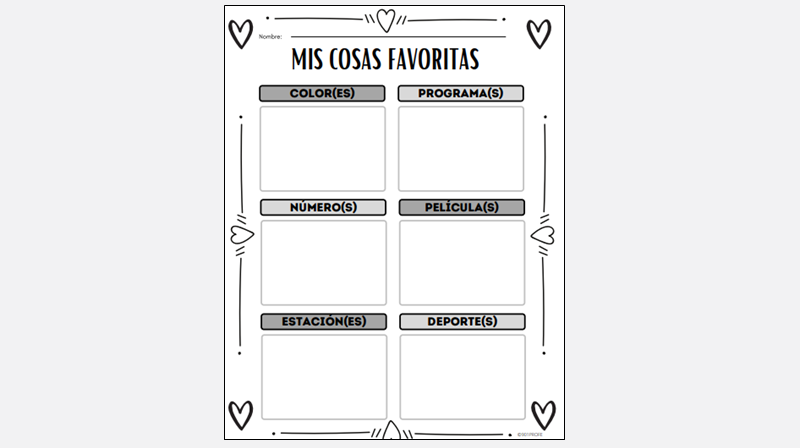
- Sé esperar mi turno | Music Video | By Miss Rosi Oficial
- This short and upbeat song teaches children the importance of waiting their turn and respecting others.
- Mi turno | Music Video | By CANTANDOCONTIGOWE (sung by Santiago Cruz)
- This is another catchy song about the importance of waiting for your turn, and not always having to be the first in everything.
- Canción para mi papá | Music Video | By Mundo Canticuentos
- This song about fathers can be incorporated into lessons about families.
- ¿Dónde está mi nariz? | Music Video | By Little Angel Español
- This song, sung by a character looking for their nose, can be incorporated into lessons about the body parts.
Pasta Skeleton Art: Students can create a skeleton using pieces of pasta. Different types of pasta can be used (e.g., spaghetti, lasagna noodles, spirals, or small shells) in order to represent the different bones of the body. When finished, students can present their skeleton to peers, using the sentence structure, “Mi esqueleto es___________” or “Mi esqueleto tiene___________” (My skeleton is/has___________). Peers can respond with utterances such as El mío es + adjective (Mine is______________). A template for this activity can be found on the Kinder ART website.
Family Tree: For this activity (which can exercise students’ linguistic, artistic, and fine motor skills), students fill in a family tree. Students can bring photos of their family and cut them out and glue them, or draw photos of their families. While assisting the student to complete this activity, the adult can model key vocabulary terms, e.g., “Mi mamá, mi papá, mi tío” (My mom, my dad, my uncle). The resource for this activity is available for free on Teachers Pay Teachers.
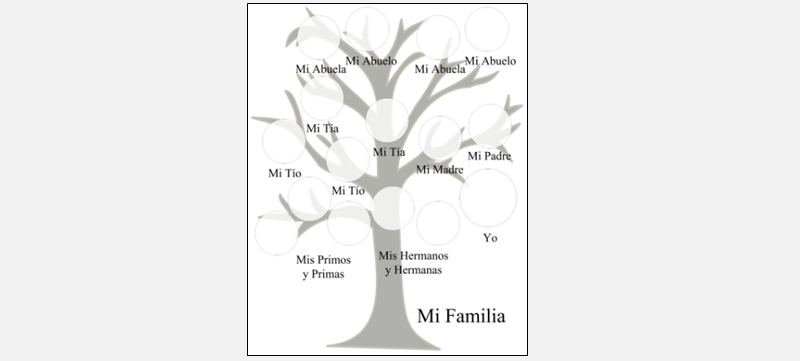
TeCuento App: Students and adults can use the TeCuento app to create books about themes which incorporate the core word(s), e.g., Mi casa, mi familia, mis cosas favoritas (My house, my family, my favorite things). TeCuento is a free application which allows students edit their own stories, incorporating Spanish sign language.
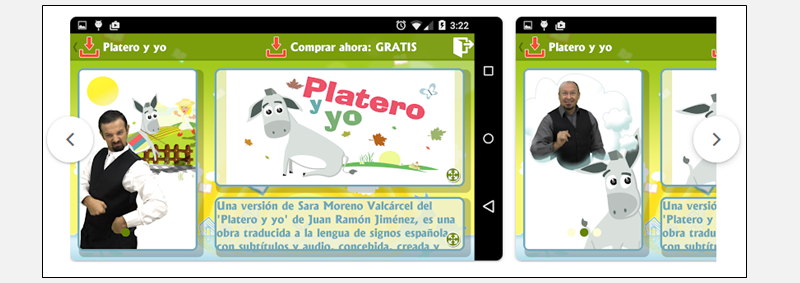
Create Your Own Superhero: Students can use creAPPcuentos to create a story about their own imaginary superhero. Students can give their stories titles such as, “Mi superhéroe” (My superhero).
Creating Videos: The students can record short videos of their family members and then share these video with peers during presentations titled “Mi familia” (My family).
WORD WALL: Create a Word Wall and add mi, mío, and mía to the list.
READING and the Word Wall: Sound out the letters together. Have the students find the word on the AAC system.
WRITING and the Word Wall: Using a pencil or alternative pencil, have students try to type the word on the keyboard, adapted keyboard or write the word together.
Choosing Words for the Classroom Word Wall with Dr Caroline Musselwhite Video. Courtesy of Edmonton Regional Learning Consortium